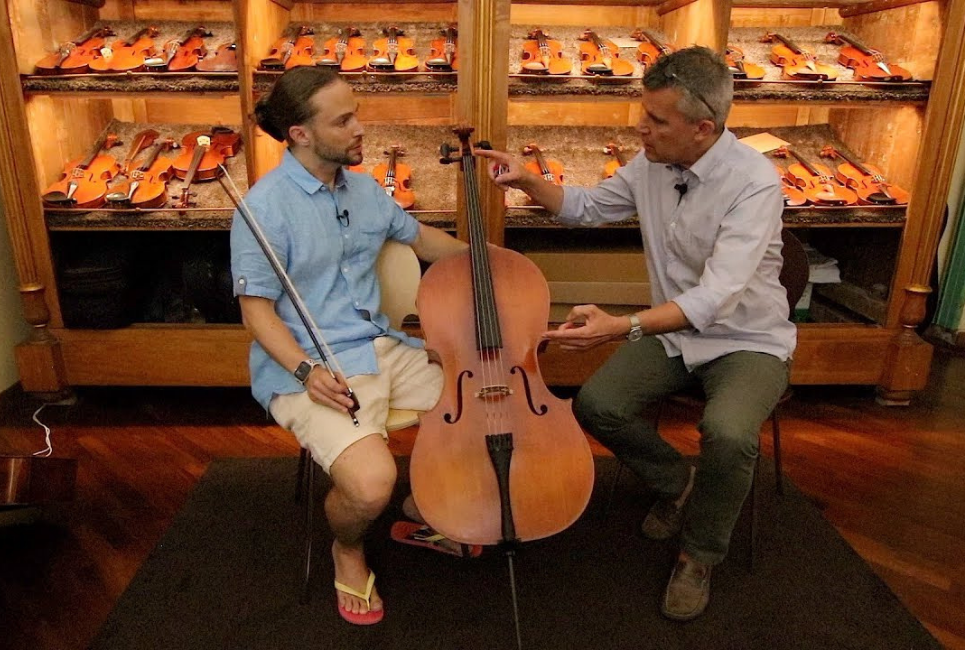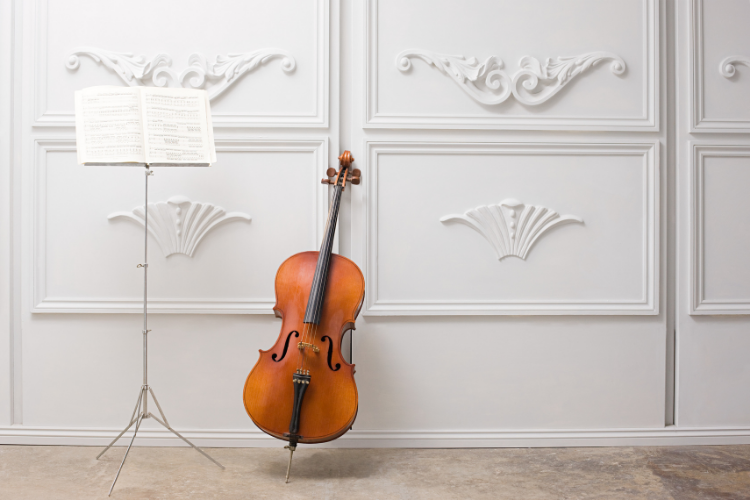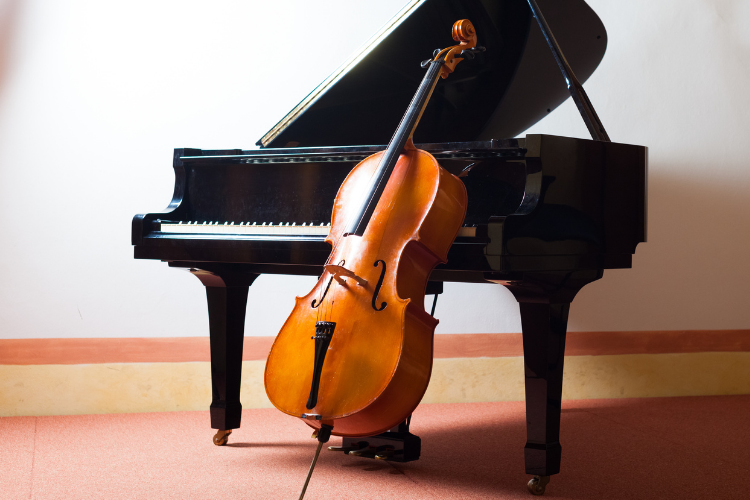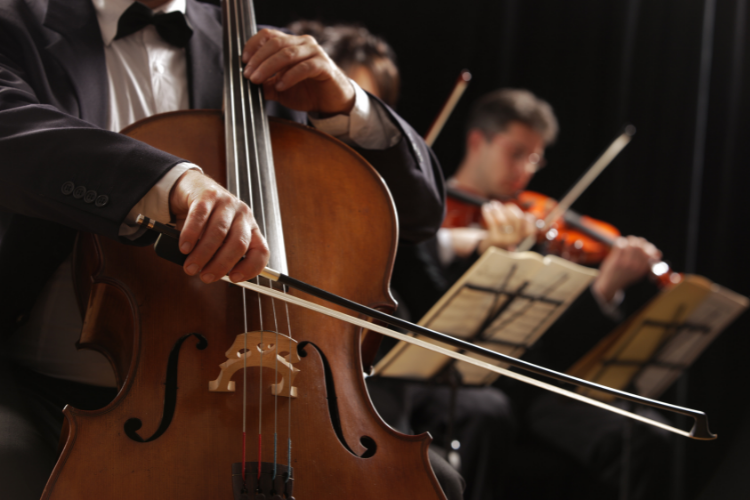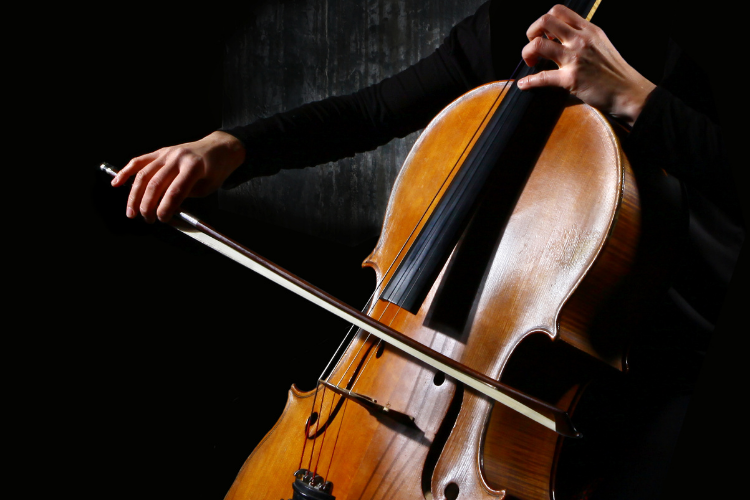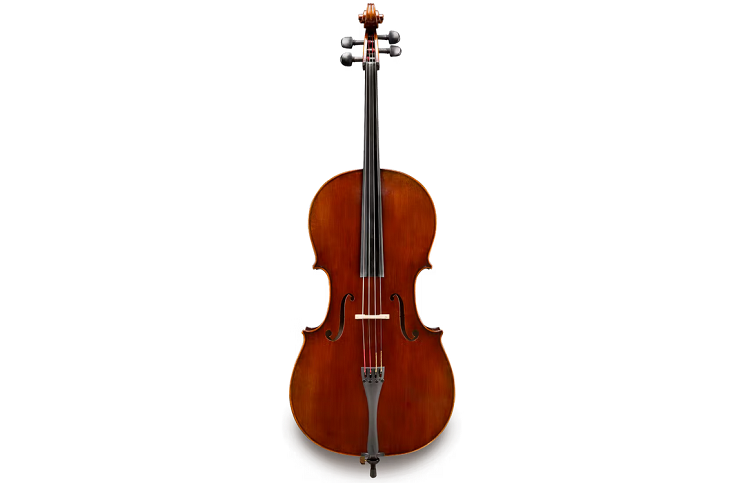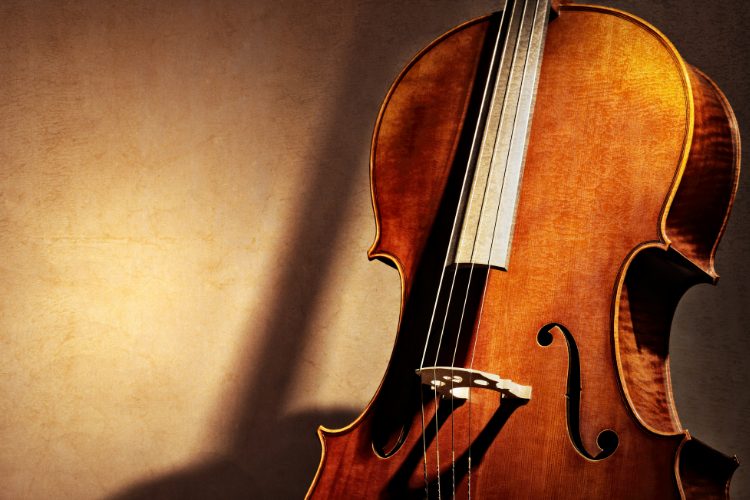- Best Violin Stand Options Guide - May 26, 2022
- Best White Violin Options - May 22, 2022
- How to Find the Best 7/8 Violin - May 19, 2022
Whether you are purchasing it for yourself, a loved one, or a child, cello shopping can be a little intimidating at times. With so many different types of wood, accessories, and brands to choose from, it can be pretty easy to forget about perhaps the most important element – choosing the correct size.
A lot of people assume that when you are buying cellos for an adult or young adult, you should always buy a 4/4 cello – it’s the industry standard, right? This is not true at all. Many people much prefer to play a 7/8 cello, the second biggest size available on the market.
I’ve had this conversation with a ton of cellists who have been uncomfortable with 4/4 cellos, and I’ve decided that it’s time I create a guide about it to summarise what I have learned.
If you’re looking to purchase a 7/8 cello but are not sure what exactly you should be looking for, this is the guide for you – read on to find out my thoughts!
Bottom Line Up Front
The Gliga Genial-2 Nitro Cello is my top pick for the best ⅞ cello, mainly due to the fantastic balance between quality and cost. ⅞ cellos are quite a niche product, and therefore many brands charge a lot for them, but Gliga has produced something that has changed this forever.
When is 7/8 an Appropriate Size?
The first thing that you will want to consider is whether a 7/8 cello is the correct size for you. As I mentioned earlier, many people avoid this cello size – this isn’t just teenagers who are growing up faster than their bodies, but it’s also grown adults!
4/4 cellos are generally recommended to anyone who is 15 years old or above, but I’ve always thought this age guideline presumes that everyone’s bodies are the same. In reality, the real recommendation is that the cellist must be more than five feet tall, and be able to comfortably navigate the full 30-inch length of the instrument.
Let me tell you straight away that whilst she does not play the cello, my 42-year-old sister is a mere 4 foot and 12 inches tall, and I can guarantee that a 4/4 cello would be too much for her. She plays the guitar and has always been more comfortable with downscaled guitar sizes, and there is absolutely nothing wrong with that.
Another circumstance in which I would deem it necessary to purchase a 7/8 cello is if a child is growing rapidly, yet they currently fit the dimensions for a ½ or ¾ cello.
Kids grow so fast, so it can often be a wise idea to purchase a cello that they can grow into, as opposed to something that they will be able to use immediately. However, I would only recommend this if they already have a cello to practice on, as they may be waiting longer than you expected!
Overall, 7/8 cellos are the closest thing to full-sized cellos without actually being full-sized. They are widely accepted in orchestral settings and present great options for smaller adults or adolescents. There is absolutely no shame in buying a 7/8 – the only thing to be worried about is having a cello that doesn’t fit your body type!
Choosing the Right 7/8 Cello
So, you’ve decided that 4/4 cellos are a little oversized for your preference, and you will instead be looking for a 7/8 cello. That’s great, but the struggle isn’t over just yet. Before you start learning your instrument, you are going to have to consider a wide variety of qualities to choose the right cello.
Luckily for you, I’m going to be breaking this information down into four key sections. Hopefully, they are as useful to you as they have been for my students!
Comfort
The first and arguably most important quality that you should look for in a 7/8 cello is simple – comfort. This is ultimately what cello sizing all boils down to.
Sure, if you were 4 foot 11 and insisted on using a full-sized 4/4 cello, you could probably make it happen through a lot of stretching. However, this is not going to be a comfortable learning experience.
Comfort is essential when purchasing a cello. If you are just beginning to learn the instrument, you are not going to want to practice frequently if the instrument does not feel comfortable.
On the other hand, if you are an experienced cellist and are looking to upgrade from a ¾ to a 7/8, you may be put off pursuing the instrument further if it does not feel natural to hold.
Whilst height and arm span do come into this, it’s important to realize that every cello is unique in its build quality. One 7/8 cello may differ greatly from another 7/8 cello in terms of its depth or the way that the fingerboard feels, and there is only one way to discover these idiosyncrasies – testing them out.
My biggest piece of advice to optimize the potential comfort of your 7/8 cello is to simply head to a music store that sells cellos and try some out.
Make sure that 7/8 is the right size for you, and identify the unique aspects of a cello build that provide you comfort. Don’t be afraid to ask one of the members of staff in the store, it is their job to find you a cello that fits you comfortably.
Cost Vs Quality
The next most important thing to be considered is of course the quality of your 7/8 cello, and how much this is going to cost you.
Cellos range massively in price – from beginner brands selling instruments for just a few hundred dollars to premium cello luthiers selling one-offs for tens of thousands of dollars, the range is huge and you are going to need to identify where your budget sits.
I would personally gauge this based on your personal experience with the instrument. Let’s say that you have been learning the cello for 15 years, beginning with a 1/8 when you were five years old and you have finally stopped growing.
You can now consider purchasing a 7/8 cello without having to think about potential upgrades in the future, so it could be time to splash out. Save up a grand or two and buy yourself something hand-carved with ebony fittings, as it’s going to see you through many years!
On the other hand, if you are a beginner cellist, this would not necessarily be wise. The only way to decide whether the cello is the instrument for you is to buy one and practice with it, so it’s not worth risking spending two thousand dollars on a premium 7/8 cello only to discover that you don’t even enjoy it!
In this case, it would make much more sense to buy a budget cello for a few hundred dollars and spend a while deciding whether you enjoy it. If you do, you can start saving up for something fancier in the future!
Ultimately, it’s undeniable that higher quality cellos are going to costs higher amounts of money, and they are inevitably going to sound a lot better too. However, you should take some time to assess whether you need this.
If you have been playing for years and have a keen ear for quality, go for it! If you’re a beginner unfamiliar with even the basics, stick to a lower budget. Simples.
Accessories
Another important aspect of choosing a 7/8 cello is the accessories that may or may not come bundled with the instrument as an ‘outfit’. Whilst many people think that cellos simply need strings and a bow, it’s not this simple. There are tons of other bits of equipment required, such as a cello case, rosin, a cello stand, a cello chair, a tuner, and more.
Many cello brands will sell their 7/8 cellos as an ‘outfit’, meaning that all of these essential accessories will come bundled with the purchase.
It’s an incredibly useful situation for beginners to the instrument, as they instantly receive everything they need to get started. The last thing you want to do is to purchase the instrument, only to discover that you have to start making additional purchases to get practicing.
Buying an outfit is also a great way to save money, as the bundle will generally cost significantly less than if you purchased all of the items individually.
However, this is not the case if you are an experienced cellist. It’s more than likely that you already have a tuner, rosin, and stand for your cello, so these outfits may not be worth it. If you are upgrading from another size, on the other hand, it will likely still be worth investing in a new cello case and stand.
Brand Reputation
The final thing that I would highly recommend you consider when shopping for a 7/8 cello is the brand reputation. I’m not just talking about purchasing a cello from a fashionable company, because after all, it’s the sound and quality that counts far more than the brand.
With that being said, some brands have excellent reputations for looking after their customers. I’m talking about providing insurance policies, lengthy warranties, frictionless deliveries, and overall satisfactory customer service.
Cellos can get expensive, especially if you are buying from premium brands, and the last thing you will want is to have a purchasing experience full of friction.
Ask around fellow cellists and check out online reviews for the reputation of cello brands that you are interested in. There’s tons of information out there, and the majority of brands are great at treating their customers well, but it’s worth doing your research to make sure you’re not opening a tin of worms.
My Top 7/8 Cello Picks
Hopefully, the information in this guide so far has informed you of when it is a good idea to consider a 7/8 cello over a 4/4 cello and what to look for in a quality cello brand.
To make things a bit easier for you, I’ve factored all of this information into my research to provide you with three 7/8 cellos that I would highly recommend. Read on to find out my top picks!
D Z Strad Cello Model 250
The first 7/8 cello I wanted to list was the D Z Strad Cello Model 250. D Z Strad is a highly reputable cello brand that I have used for many years, but I’ve always found it frustrating that they don’t provide any 7/8 options. Well, the Model 250 is now provided in 7/8 at a heft price of $2,500, but trust me – you get a lot of bang for your buck.
This beautiful cello has a Spruce Top, a Maple Back, and of course, that sought-after Ebony fingerboard. The wood used to produce this cello has been dry-treated and ventilated for over 10 years, ensuring that it holds its durability for as long as possible. It also comes with a truly grand case, a Brazilwood bow, and some Rosin to get you started.
It must be said that it’s a pricy option for a 7/8 cello (albeit significantly cheaper than some of the one-off $10,000 cellos on the D Z Strad website), but you pay for what you get, and with the Model 250, you get some truly premium quality.
Pros
- Ebony fingerboard
- The wood has been dried slowly over 10 years to prolong longevity and prevent wood contraction/expansion
- Comes with a bow, case, and rosin
Cons
- $2,500 is a lot of money to spend on a beginners cello, so I would only recommend this for experienced cellists
- Despite the price, the cello is still not fully hand-carved (although elements are)
- It’s the only 7/8 option available through D Z Strad, limiting your choices somewhat
Eastman Strings Rudoulf Doetsch VC701
Whilst I’ve always loved the products of D Z Strad, there’s one other company that I have used even more, and that is Eastman Strings.
This cello producer is well known for not only producing some exquisitely designed cellos but selling them for a very reasonable price. The Eastman Strings Rudoulf Doetsch VC701 is a prime example of this, a 7/8 cello sold at around $2,000.
It’s still undeniably a lot of money to spend on a cello, but it comes with some serious quality. The instrument is hand-crafted by Eastman’s famous master luthiers, set up manually to provide optimum resonance and amplification, and finished off with a truly stunning Antiqued Spirit Varnish.
The sound and quality of this instrument are far more important than the aesthetic, but if you can track this instrument down in a store and see it for yourself, you’ll realize why I love this 7/8 cello so much – it is stunning!
Pros
- A truly gorgeous Antiqued Spirit Varnish finish
- Hand-crafted by the critically acclaimed Eastman luthiers
- $2,000 is excellent value for money
- Gorgeous resonance and amplification
Cons
- Despite the excellent value, $2,000 may still be considered too expensive for many people
- The bow and other accessories will have to be purchased separately
Gliga Genial-2 Nitro Cello
The last entry that made it on my list of the best 7/8 cellos is the Gliga Genial-2 Nitro Cello. I have to say that this is a brand that I was not familiar with until recently, yet when I expressed this to people, they were astonished.
This company has a very good reputation in the cello world, particularly for providing affordable and high-quality options to students.
Something that stands out to me about this instrument is the way that Gliga has produced a niche 7/8 cello that can often be difficult to find without charging an extortionate fee. Believe it or not, this stunning instrument can be purchased for just over $1,000, which is half the price of the other options on this list.
It’s handmade in Romania, manually set up by professional luthiers, and even has a solid ebony fingerboard! That is very rare for a cello that is so cheap.
These factors make this instrument my top choice on this list – sure, the Eastman and D Z Strad 7/8 cellos are of better quality, but not everyone can afford their products, and I believe this needs to be recognized.
FAQs
So, we’ve taken a look at why you might want to purchase a 7/8 cello over a 4/4 cello, what you should look for specifically when making such a purchase, and some of the top brands and models that I would recommend.
Hopefully, I’ve answered most of your questions already, but let’s finish up with a quick FAQ just in case any queries remain.
Answer: Of course! It is a common misconception that one must use a full-sized 4/4 cello in an orchestra – this is a thing of the past. These days, everyone recognizes 7/8 cellos as perfectly suited for professional performances.
Answer: Whilst these things certainly are not black and white, 7/8 cellos are generally best suited for adults or adolescents that are 5 feet tall or below and have an arm span of fewer than 30 inches.
Answer: Eastman Strings produce some truly beautiful premium cellos, but they are generally considered to be too expensive for a beginner cello brand.
Answer: Unless you already own them, you should consider purchasing a cello that comes bundled with a case, spare strings, rosin, cello stand, cello chair, and most importantly, a bow.
Conclusion
I hope that this guide on the best 7/8 cellos has helped you prepare for your purchase! It can be a confusing world out there, but as long as you do your research and try out some 7/8 cellos in person, I am sure that you will be happy with what you purchase eventually.
I’ve discussed a lot of good brands today, but I would recommend the Gliga Genial-2 Nitro Cello more than any other, particularly for beginners. It’s a very affordable yet gorgeously crafted cello which I think finds a perfect balance between cost and quality. It’s rare to see this in 7/8 cellos these days.
Good luck on your cello journey, and I wish you all the best. Hopefully, you will be as happy with your cello as I am.
Looking for more interesting readings? Check out:

